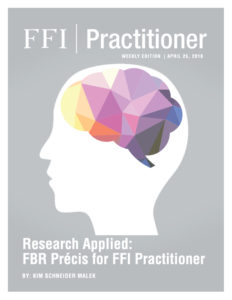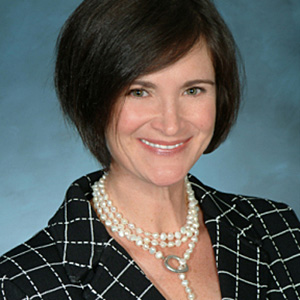
View this edition in our enhanced digital edition format with supporting visual insight and information.
Among the unique characteristics differentiating family enterprises from their non-family counterparts is that family-owned businesses are much more driven by nonfinancial social and emotional motivators. In this week’s edition, Kim Schneider Malek explores the research that has been conducted on socioemotional wealth through her précis of “More Than Meets the Eye: A Review and Future Directions for the Social Psychology of Socioemotional Wealth,” an article appearing the March 2018 issue of FBR.
Background on Socioemotional Wealth (SEW)
The long-standing pervasive business theory of the single-minded pursuit of maximizing shareholder value has always been incongruous for family businesses and enterprising families. While they may be more obvious and quantifiable, profit and wealth generation are rarely the exclusive goals, nor the sole driving reward factors, for controlling-ownership families. Meeting the nonfinancial social and emotional needs — consciously and subconsciously held within the controlling family members — also is an inherent goal influencing various aspects of organizational life and decision reference points in family firms. This is referred to as the unique family firm phenomena called socioemotional wealth.
Socioemotional wealth (SEW) has been a prevailing research topic in the family firm field for the past 10 years. It is considered one of many psychological micro-foundations inspiring family firm research. Scholars have commonly defined SEW as “the non-financial aspects of the firm that meet the family’s affective needs” (Gomez-Mejia, Haynes, Nunez-Nickel, Jacobson, & Moyano-Fuentes) a “stock of affect-related value that the family has invested in the firm,” an affective endowment (Berrone, Cruz, Gomez-Mejia, & Larraza-Kintana), and a socioemotional endowment (Berrone, Cruz, Gomez-Mejia), as well as many other conceptualizations that deal with various nonfinancial social and emotional benefits that a family member derives from control over a particular firm.
More Than Meets the Eye
In their FBR article, “More Than Meets the Eye: A Review and Future Directions for the Social Psychology of Socioemotional Wealth,” the authors seek to address, through assessment, several criticisms of the first 10-years of SEW research, specifically:
- Not yet identifying the locus and drivers of individual family member’s SEW;
- Risking reification (meaning making something more concrete and devoid of the human activity that causes it); and
- Not applying more social psychology aspects to the research.
To complete their assessment, the authors narrowed their literature search to 421 existing SEW-related papers published in 25 journals.
SEW and Social Psychology
One of the key considerations in the authors’ research was using social psychology as an overlay for the assessment process. According to psychologist Gordon Allport, social psychology is a discipline that uses scientific methods “to understand and explain how the thought, feeling, and behavior of individuals are influenced by the actual, imagined, or implied presence of other human beings.” The authors affirmed how and why additional use of social psychology can help SEW researchers avoid reification and rejuvenate the SEW research agenda.
To design their assessment lens, the authors used three hallmark approaches and five core tenets of social psychology. These ultimately explained the cause and effect of why, how, and when family members’ actual, imagined, or implied interaction through a firm they control induces individual and collective thoughts, feelings, and behaviors that lead to unique SEW phenomena (Jiang, Kellermanns, Munyon, and Morris).
Five core tenets (principles believed to be true) of social psychology were applied to categorize assessments and help uncover many mechanics that frame unique nonfinancial decision reference points in family firms. These tenets are:
- Social
- Motivational
- Cognitive
- Affective
- Behavioral
In their quest to gain greater insight into the locus and drivers of SEW within the individual family members, the authors also framed their analysis perspective employing three hallmark approaches of social psychology. These are:
- A belief in the power of groups (in this case, the family) as a normative influence;
- A focus on understanding subjective meaning of the nonfinancial aspects rather than the objective financial aspects of control and involvement in the firm; and
- An emphasis on understanding the complex and nonobvious relationship when families control or are involved in organizational life.
Some Implications for Practitioners
- Socioemotional wealth research is a valuable knowledge resource for any family firm practitioner. When we help families explore and pursue their enterprising goals, we need a better understanding of SEW and how it impacts the decision reference points on which we are there to advise or expose. Further, appreciating the SEW research through a lens of social psychology will advance our pursuit of understanding how individual family members think, feel, and behave relative the family normative group and the collective understanding of the perceived influence of SEW.
- We might also reflect on how our methods and models of helping families and individuals gain insight into the concept and theoretical perspectives of SEW might inadvertently be contributing to the risk of reification. In the spirit of systematizing our insight and feedback to clients, are we trying to materialize and form human activity and emotions whose provenance resides inside individual family members?
- Additionally, what are we doing to create greater awareness in the family and firm of how decisions are made from a social psychological perspective and to raise an awareness of the invisible presence, yet, powerful influence, of SEW? In what way might we be treating family firm control as the genesis of SEW rather than looking at how, why, and when emotions of individual family members are what we should be considering.
- Finally, do we, as practitioners from a variety of professions, know enough about social psychology to respect the research considerations suggested by these authors? What can we learn about social psychology that would allow us to enthusiastically anticipate and integrate into our practice the results of the new research agenda?
In conclusion, the family has many taken-for-granted influences on what drives stakeholder, not just shareholder, value, and wealth. The continued work of these authors and the extended research they and others produce using social psychology will help make SEW one of those better-understood and transforming psychological micro foundations of family firms.
About the contributor
 Kim Schneider Malek, FFI Fellow, is founder of Family Enterprise Alliance, LLC. She specializes in helping families, businesses, and boards navigate unity, succession, governance, culture shifts. She is the recipient of the 2014 Barbara Hollander Award and was the founding co-editor of FFI Practitioner. Kim also served for 15 years as adjunct graduate-level faculty teaching family enterprise sustainability at the University of Denver’s Daniels College of Business. She can be reached at kim@advancingfamilyenterprise.com.
Kim Schneider Malek, FFI Fellow, is founder of Family Enterprise Alliance, LLC. She specializes in helping families, businesses, and boards navigate unity, succession, governance, culture shifts. She is the recipient of the 2014 Barbara Hollander Award and was the founding co-editor of FFI Practitioner. Kim also served for 15 years as adjunct graduate-level faculty teaching family enterprise sustainability at the University of Denver’s Daniels College of Business. She can be reached at kim@advancingfamilyenterprise.com.
About Family Enterprise Alliance, LLC
Family Enterprise Alliance, LLC is a firm leveraging more than 50-years of multi-generational expertise dedicated to advancing family businesses, enterprising families, governance councils, and the professional field committed to helping them progress towards their goals for continuity.

View this edition in our enhanced digital edition format with supporting visual insight and information.





